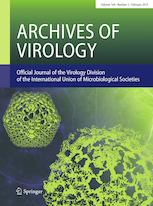Ver ítem
- xmlui.general.dspace_homeCentros e Institutos de InvestigaciónCIAP. Centro de Investigaciones AgropecuariasInstituto de Patología VegetalArtículos científicosxmlui.ArtifactBrowser.ItemViewer.trail
- Inicio
- Centros e Institutos de Investigación
- CIAP. Centro de Investigaciones Agropecuarias
- Instituto de Patología Vegetal
- Artículos científicos
- Ver ítem
Complete genome sequence of a divergent strain of Tibetan frog hepatitis B virus associated with a concave‑eared torrent frog (Odorrana tormota)
Resumen
Viruses of the family Hepadnaviridae are characterized by partially dsDNA circular genomes of approximately 3.2 kb, which are reverse transcribed from RNA intermediates. Hepadnaviruses have a broad host range, which includes humans (hepatitis B virus), other mammals (genus Orthohepadnavirus), and birds (genus Avihepadnavirus). The known host specificity of hepadnaviruses has been expanded by reports of new viruses infecting fish, amphibians, and reptiles.
[ver mas...]
Viruses of the family Hepadnaviridae are characterized by partially dsDNA circular genomes of approximately 3.2 kb, which are reverse transcribed from RNA intermediates. Hepadnaviruses have a broad host range, which includes humans (hepatitis B virus), other mammals (genus Orthohepadnavirus), and birds (genus Avihepadnavirus). The known host specificity of hepadnaviruses has been expanded by reports of new viruses infecting fish, amphibians, and reptiles. Tibetan frog hepatitis B virus (TFHBV) was recently discovered in a member of the species Nanorana parkeri (family Dicroglossidae) from Tibet. To increase our understanding of hepadnaviruses that infect amphibian hosts, we identified the full-length genome of a divergent strain, TFHBV-Ot, associated with a concave-eared torrent frog (Odorrana tormota, family Ranidae) from China by searching deep-sequencing data. TFHBV-Ot shared a genomic organization and 76.6% overall genome sequence nucleotide identity with the prototype TFHBV associated with N. parkeri (TFHBV-Np). The pairwise amino acid sequence identity between the predicted gene products of TFHBV-Ot and TFHBV-Np ranged between 63.9% and 77.9%. Multiple tissue/organ-specific RNAseq datasets suggested a broad tropism of TFHBV, including muscle, gonads and brain. In addition, we provide information about putative virus-derived small RNAs from an amphibian hepadnavirus. The results presented here expand the known genetic diversity and host range of TFHBV to Ranidae frogs, and warrant an investigation of hepadnaviral infection of amphibian brains.
[Cerrar]

Autor
Debat, Humberto Julio;
Fei Fan Ng, Terry;
Fuente
Archives of virology 164 (6) : 1727–1732. (June 2019)
Fecha
2019-06
Editorial
Springer
ISSN
0304-8608
1432-8798 (Online)
1432-8798 (Online)
Formato
pdf
Tipo de documento
artículo
Palabras Claves
Derechos de acceso
Restringido
 Excepto donde se diga explicitamente, este item se publica bajo la siguiente descripción: Creative Commons Attribution-NonCommercial-ShareAlike 2.5 Unported (CC BY-NC-SA 2.5)
Excepto donde se diga explicitamente, este item se publica bajo la siguiente descripción: Creative Commons Attribution-NonCommercial-ShareAlike 2.5 Unported (CC BY-NC-SA 2.5)

